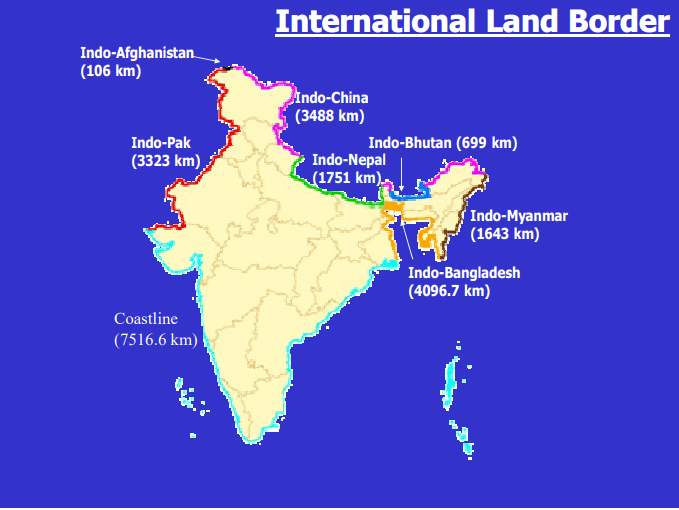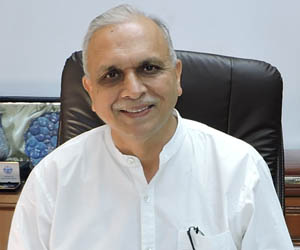(The following is the updated version of Keynote Address delivered by the Director VIF at Security and Policy Initiatves (SAPI)Conference on 26th October 2021)
Borderlands are subject to diverse influences. The peripheries of a country are extremely sensitive. We need to pay special attention to them. Failure to do so can result in serious consequences for a country’s security and prosperity.
Settled, peaceful, relatively open orders are a source of security and prosperity. That is why in many regions of the world the attempt is to keep the borders relatively open and free for trade and human traffic. Borders define neighbours and impact relations with them.
India is a civilizational state. Its cultural footprint extends far beyond its boundaries. Unfortunately, with the partition of India, what emerged was a geographically diminished India. The boundaries drawn were artificial and arbitrary. Pakistan was created out of a pernicious two-nation theory and after much violence. The legacy of India Pakistan border is complex and bloody.
With Tibet, India had civilisational links. There were no demarcated boundaries. People and ideas crossed the boundaries with ease. Instead of boundaries, there were spheres of influence. With China annexing Tibet we had for the first time in history a border with China. That border is still unsettled and is likely to remain so in the foreseeable future.
The nature of borders is changing. Population changes, changes in terrain, economic development impact the nature of border areas. Globalisation requires that crossing borders should be easy. Yet, the problem of illegal migrations and corona has ensured that border controls are becoming stricter.
A wishful thing does not help. We have to manage our borders given the present-day reality.
Indian Borders
India has a multidimensional border management problem. It has long land and coastal borders 15000 Km and 7500 km respectively. 456 Blocks of 119 border Districts in 16 States and 2 Union Territories abutting the International Boundary. Many Indian states have long coasts. Managing land borders is very different from managing coastal and riverine borders.
In the Indian context, a few features stand out.
- India has Bangladesh 4096 km of border with Bangladesh, 3323 km with Pakistan, 3488 Km with China, 1751 km with Nepal, 699 km with Bhutan, 1643 km with Myanmar.
- Sections of the boundaries are unsettled.
- The neighbours are often hostile.
- Terrains are diverse and difficult.
- Border areas are underdeveloped.
- Connectivity with the hinterland and across to other countries is poor.
- Border populations feel insecure.
- Borders areas in remote parts are getting depopulated.
- Illegal migrations, which alter demographic ratios, present a major challenge.
- The smuggling of contrabands, arms and ammunition drugs etc is rampant.
Border guarding forces need material and financial resources, training and aptitude for border management.
Border management requires a strategy and a holistic multi-stakeholder approach. In the wake of the Kargil conflict, the government set up four task forces to review the national management system in the country. One of these was on border management. That was the first time we looked at the borders holistically, as part of national security management. The recommendations of the task force were accepted by a group of ministers.
A department of border management (DBM) in the MHA was set up. DBM has been spearheading the bordermanagement effort in the country. Some of the tasks it has performed are: the construction of the border guarding infrastructure, construction of integrated check posts to facilitate trade and movement of people, socio-economic development of border areas. MHA also equips and trains the border guarding forces. A principle of one border one force has been accepted to streamline the deployment of border guarding forces.
Close coordination between central and state agencies is essential. This is not often the case. The land is a state subject. Building infrastructure requires land and environmental clearances and a host of other approvals. The complexity of centre-state relations makes border management that much more difficult. Stares often see the presence of central agencies on the border areas with disapproval.
India has spent a lot of resources in building fences and associated infrastructure over the last three decades. It has also built the capabilities of border guarding forces to guard and manage the borders. This has had a positive impact on checking infiltrations, reducing smuggling, curbing contrabands etc.
MHA has also professionalised the border guarding forces – BSF, ITBP, SSB, AR, Cost Guard. Quite often other departments like the Ministry of External Affairs, Ministry of Defence, Ministry of Finance, Minstry of Commerce, Railways etc are also involved in this exercise.
Yet, the problems remain.
The MHA approach seems to be to curb and regulate rather than facilitate. Taking border area populations into confidence and generating trust in local populations is very important.
Border areas require more connectivity and more socio-economic activity. They need more security and more reasons to remain where they are. Illegal migrations from the border areas can be highly destabilising. The border management must take this into account.
International cooperation is also essential. India Bangladesh border has stabilised due to much better coordination between the BSF and BGB.
Northeast is the gateway to ASEAN which is relatively a prosperous area. India is committed to improving connectivity with ASEAN. The vision of connecting ASEAN with Asia through India is laudable but there are many problems. The issue is connectivity and the developmental potential of the region. The other issue is the relative lack of development in the North East. There is fear that opening the borders with Myanmar would swamp the Northeast with Chinese goods. The problem is that this is already happening through illegal means.
The Northeast receives drugs, arms and other contraband through the porous borders. The border with Myanmar is porous and is affected by intractable insurgencies on the Myanmar side. That makes border management that much more difficult.
The Northeast’s full potential can be realised if the order activities like border trade etc are facilitated and connectivity is built. NE can be linked with ASEAN.
Coastal Borders
The management of Coastal borders is a problem of a different scale altogether. The Mumbai terror attacks brought home the need to strengthen coastal surveillance. Coast Guard patrols the territorial sea while the Navy operates in the high seas.
Sea routes are used to smuggle people, arms, drugs and other contraband. India has made some progress in improving the coast surveillance but it is difficult to achieve total success. The use of technology becomes imperative in managing large borders, be it on land or the sea or the rivers. In particular GPS, satellite surveillance become important.
Lakhs of boats and ships pass through Indian seas. Monitoring them requires a coordinated approach based on the use of technology. The Indian Navy has set up a fusion centre for white shipping as well as coastal surveillance radars to generate maritime domain awareness.
The government is thinking of setting up a maritime commission to deal with coastal security. This will help bring the required focus on the problem, improve the coordination and help monitor the various projects.
Coastal police need to be strengthened. The problems of island territories require a special focus and approach. Andaman and Nicobar Islands are highly strategic as well as ecologically fragile. We need special policies for the development of these islands. The same can be said of the Lakshadweep Islands.
South Asia is the least integrated region in the world. That is unfortunate because there are natural affinities between the people of the region. But instblity in heegion has imoeded integration.
India has the vision of integrating Soth Asia into an economic whole. SAARC, BIMSTEC and BBIN are efforts in that direction. This will require connectivity and relatively free movements.
The challenge of border management is how to ensure that borders are secure and yet they are accessible.
The approaches such as those by the DBM look at one aspect of the problem but not the other. We need a balanced approach.
The key to border management is to take people-centric approaches and make them partners in national security. Good cooperation with the neighbours is also essential.
Further, we should harness space technologies, IT, and modern methods of infrastructure construction to ensure better border management.
In developing good border management policies, we must also be aware that in making and implementing border management policies, states have to adhere to their obligations under international law. The Human Rights convention, the Geneva Conventions on International Humanitarian Law, The WTO Doha Development Agenda and the Addis Ababa Action Plan, UN Conventions against transnational organised crime and the protocols, the UN Global Counter-Terrorism Strategy and UN Sustainable Development Goals are all relevant.
Let me quote from a paper published by the International Organisation for Migrations, a UN agency:
“Good border management… serves a dual purpose, helping to balance States’ interests in both facilitating cross-border movements and maintaining security. Achieving this balance depends upon border management policies and interventions focused on four areas of work: 1) identity management, 2) Border Management Information Systems (BMIS), 3) Integrated Border Management (IBM) and 4) Humanitarian Border Management (HBM).”
India is in the process of evolving a robust and balanced border management system that balances the cross border flows with national security interests. We need to study and evolve good borer management practices.
The border management approach is fragmented and siloed. Perhaps we need a high-level Border management Commission to evolve a whole-of-government approach to border management.
Border management is not just deploying border guarding forces on the border. We need to think through the issues more deeply. I am glad that Security and Policy Initiatives (SAPI), founded by Mr Pradeep Gupta and three highly experienced co-founders, are looking at the issues of transfer of technology and border management closely. These issues are very relevant in the making of an Atmanirbhar Bharat. As a unique think tank, SAPI will be able to draw attention to these issues, do cutting edge research, and generate new ideas to promote a multi-stakeholder approach to border management.
Appendix
The Department of Border Management, Ministry of Home Affairs has been implementing the Border Area Development Programme (BADP) through the State Governments as part of a comprehensive approach to Border Management. The programme aims to meet the special development needs of the people living in remote and inaccessible areas situated near the international border and to saturate the border areas with the essential infrastructure through convergence of Central/State/BADP/Local schemes and participatory approach.
BADP was initiated in the border areas of the western region during that Seventh Five Year Plan period for ensuring balanced development of border areas through development of infrastructure and promotion of a sense of security among the border population. Presently, the Programme covers 456 Blocks of 119 border Districts in 16 States and 2 Union Territories abutting the International Boundary viz. Arunachal Pradesh, Assam, Bihar, Gujarat, Himachal Pradesh, Jammu & Kashmir (UT), Ladakh (UT), Manipur, Meghalaya, Mizoram, Nagaland, Punjab, Rajasthan, Sikkim, Tripura, Uttar Pradesh, Uttarakhand and West Bengal. Under this programme priority is given to the areas closer to the border.
BADP is an important intervention of the Central Government to bring about development of border areas by supplementing the State Plan Funds to bridge the gaps in socio- economic infrastructure on one hand and improving the security environment in border areas on the other.
(The paper is the author’s individual scholastic articulation. The author certifies that the article/paper is original in content, unpublished and it has not been submitted for publication/web upload elsewhere, and that the facts and figures quoted are duly referenced, as needed, and are believed to be correct). (The paper does not necessarily represent the organisational stance... More >>
Image Source: https://lotusarise.com/indian-geographical-extent-and-frontiers-upsc/











Post new comment